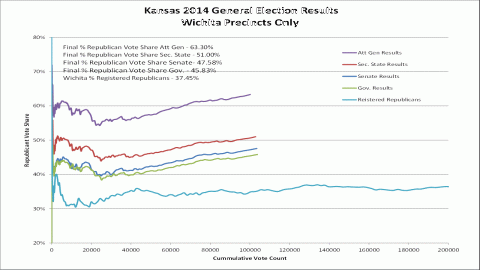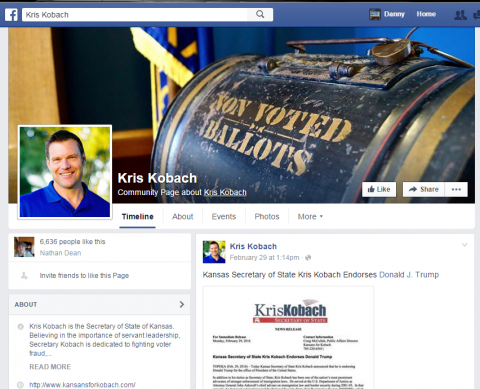It all started when a humble statistician from Wichita State University wanted to audit the voter machines in her county to address a statistical annomily that she discovered, suggesting that the voting machines where being sabotage. In laymen's terms, the concern was about the trend showing that the Republican candidates where recieving more and more votes in denser and denser urban locations - something that would go against common knowledge of how and where conservatives and liberals vote.
Elizabeth Clarkson, the nice math lady from WSU and certified quality engineer, began her quest as early as 2013. Clarkson first requested a recount of the November 2012 elections in Sedgwich County, but she didn't' get far before her first road block. Election officials had said too much time had past between the November 2012 elections and the request. She then asked that they be released per an open records request, after all, these particular machines in Sedgwich county did provide a paper printout of the votes, known as Real Time Voter Machine Tapes, and not the names of the voters. So she should be able to audit them, right? Wrong. They denied her there as well, claiming that Real Time Voter Machine Tapes where, in fact, ballots and were a special exemption from the law.
As we'll soon see, that was only the beginning.
She set her sights on the upcoming 2014 elections. The elected officials in question? The highly unpopular Governor of Kansas, Sam Brownback, the Secratary of State, Kris Kobach (who's name will come up frequently throughout this article), and two others. All showing the same statistical annomily suggesting that they were getting far more votes then they should have. Sam Brownback won his re-election by less than a 4 percent margin.
The pattern shows that the number of republican votes goes up as the commulative vote count goes up, but what's even more distirbing is how the pattern is exactly the same for all 4 elected officials.
In early 2015 she filed a recount request before time could expire, like what happened in 2014. But this time, the courts kindly told her to shove off. "Sedgwick County election officials refused to allow the computer records to be part of a recount and told her that to get paper recordings of votes, she would have to go to court and fight for them," according to a report by the Wichita Eagle.
So that's exactly what she did. She filed a lawsuit against the Sedgwick County Election Office and Kansas Secretary of State Kris Kobach.
Kobach simply pretended like his office never received the court summons. And when he didn't show up, the Judge dismissed the case. His excuse? The summons needed to be served by a lawyer, not a professor making a meager living and probably can't afford to hire a lawyer. Fortunitally for her, a lawyer - likely spurred by the media coverage all of this was now getting - stepped forward to work pro bono. He served the summons, a trial date was set, and everything was starting to look like Dr. Clarkson was finally going to be able to count the votes.
There was a pre-trial hearing because the Elections Commissioners office motioned to have the case dismissed. Then it happened, everyone's worst fear. In a packed court room overflowing with hundreds of supporters, the judge ruled that Clarkson could not access the voter records because law states you cannot fight the same legal issue twice, claiming that she had already "lost" the same case in 2015 when she tried to represent herself without a lawryer.
The fight was over. The election officials had won before the case could go to trial, and Dr. Clarkson would never be allowed to audit the machines or ask for a recount.
Kris Kobach facebook page, featuring an image that reads "NON VOTED BALLOTS." Is it a clue that he is a fan of the era when African Americans only counted for three fifths of a vote and when big city bosses would rig elections? Is it a hint that he, as the architect for the new voter suppresion tactics in America, is creatinga new era of vote rigging?
But questions still remain. What are they trying to hide? How exactly did Sam Brownback get re-elected? And why is Kris Kobach, the architect behind the new voter suppresion laws in America, claim to be so tough on voter fraud while trying to silence a humble statistician who just wants to count the votes?
Just like the votes, the answers are inside the voter machines.
Sedgwich County's iVotronic DRE-touchscreen voter machines are made by Election Systems & Software, or ES&S for short. Founded in 1979 by Bob and Todd Urosevich (a pair of right-wing zealots), ES&S is no stranger to election fraud. Not only has ES&S been accused of rigging the election for Chuck Haggle, but, together with another company owned by the Urosevich brothers, have a monopoly on the DRE market. That other company? Diebold. Yes, the same company that's been charged with falsifying records and bribing officials. Diebold and ES&S's world-wide criminal activity doesn't stop there of course.
The iVotronic DRE machines come installed with proprietary software that experts say are ripe with exploits. But because the software is proprietary, not even state election officials are allowed to inspect the code. That didn't stop Diebold from "accidently" putting ES&S's entire unencrypted Global Election Management System (GEMS) code base in all it's glory (a Microsoft Windows-based piece of software) on a website where any passer-by could download it. And that's exactly what Bev Harris did in 2003. Once exposed, Diebold quickly removed it and claimed ignorance, but the damage had been done as the code was being shared from hacker to hacker. And according to their analysis, it was a dream come true for any anyone, skilled in computer hacks or not, who wanted to rig an election.
Since then Diebold, ES&S, and all their subsidiaries have been involved in so many mergers and name changes that it becomes very difficult to place accountability. But that doesn't stop the vote rigging from occuring.
One lesson we can learn from all of this, and one that Dr. Elizabeth Clarkson has strongly advocated, is that voter machines need to be operated by open-source software. Open-source software can be inspected, scrutinized and vetted by the community. Not true for proprietary software like GEMS.
Or we can simply demand paper ballots.
[update]
About a year and a half after writing this article, I want to say a few things:
- I raised the possibility that Kris Kobach was fighting Dr. Clarkson's vote machine audit request because he was hiding something. At this point, that can neither be proven nor disproven. But we know a lot more about Kris Kobach now. He is the co-commissioner of President Trump's Voter Fraud Commission - which is itself a fraud. And today, BuzzFeed News is sueing Kobach to gain access to emails via Kansas's Open Records Act. And how is Koback responding? He's stonewalling them. Is this a pattern? Does he just like to cause as much frustration as possible for those he sees as leaning left? Or, is he again trying to hide something? Both are strong possiblities, and I would argue that the truth is a mix of both.
- During the November 2016 general election, Dr. Beth Clarkson organized a citizen exit poll for a few precincts in Wichita. The results of the aunonymous exit poll seem to indicate the the vote counts where altered. That is alarming. However, an exit poll is not evidence and there's proof that they're not as reliable as they used to be. Witnesses also described the exit poll workers as having an obvious left-leaning apperance, which might and probably would deter right-leaning voters from talking to them. It's unfortunate that some folks wouldn't want to talk to college kids and middle-aged women holding clip boards. That being said, it sure would be nice if we could have transparent voter machine audits so that we don't have to worry about them being rigged in the first place.
- This is still happening all over the country: http://abcnews.go.com/Technology/wireStory/apnewsbreak-georgia-election…
[update 2]
ES&S has admitted in a letter to a federal lawmaker that the company installed remote-access software on election-management systems. That software is called pcAnywhere. In 2006, hackers stole the source code for pcAnywhere, though the distributor for pcAnywhere didn't admit it until they were forced to years later when the source code was found by hacktivist group Anonymous. Source code is valuable to hackers because it allows them to easily identify vulnerabilities in the software... software that was designed to allow users to remotely access computers, only this time it was computers that managed elections. What could go wrong?
In 2016, Roger Stone said that Wisconsin Governor Scott Walker has rigged five election, and he conseded that both parties are involved in voting machine manipulation. However, he didn't provide any evidence.


